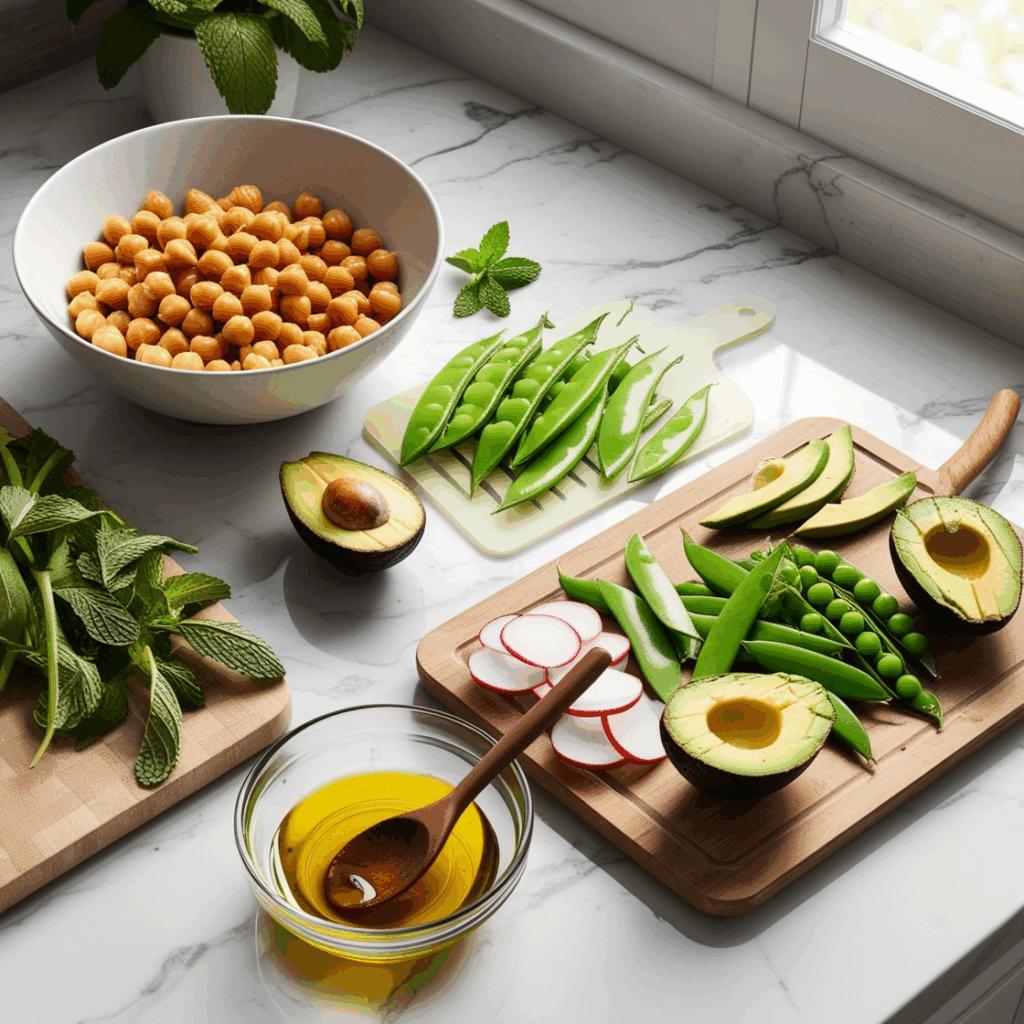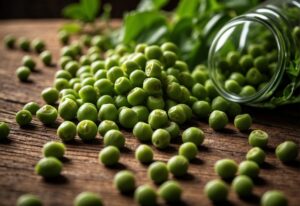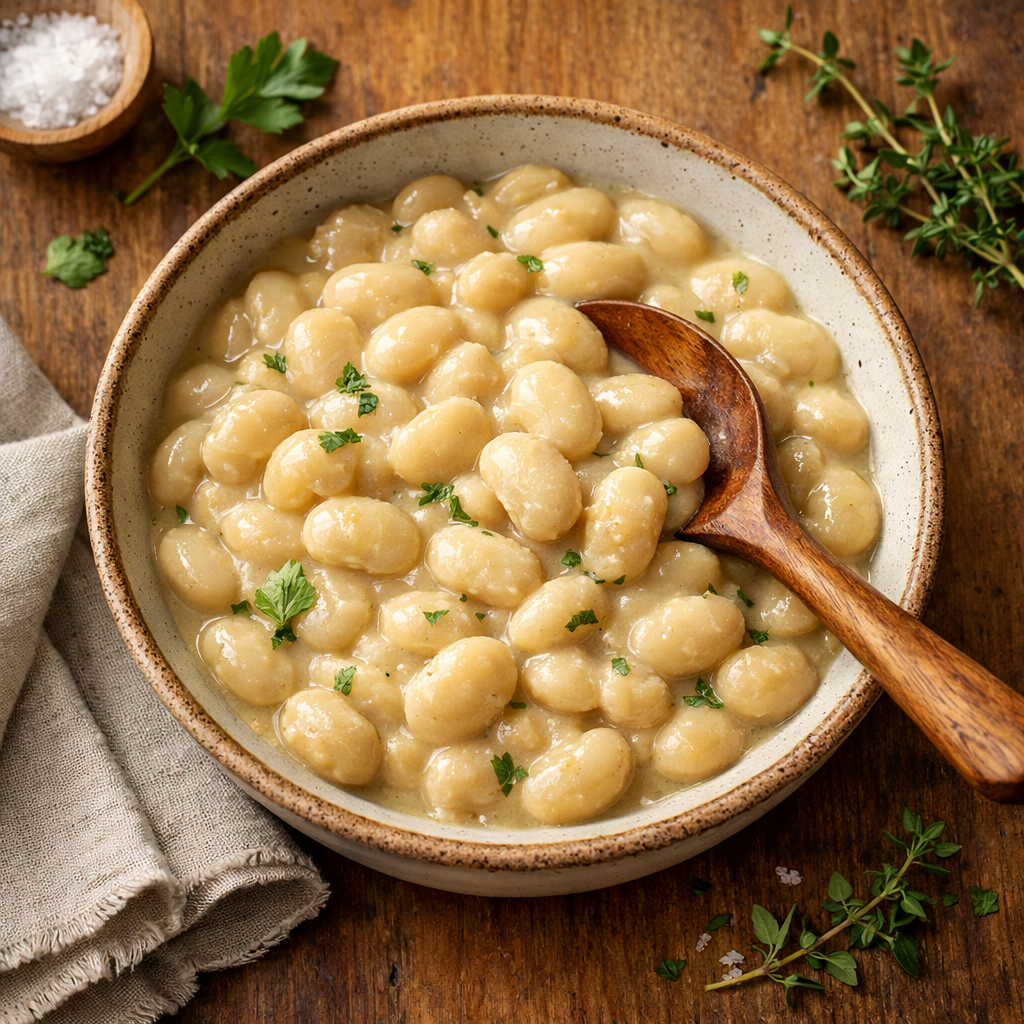Those green chickpeas at the farmer’s market always get my attention. They look so bright and happy that I end up buying them every time. When I first tried them, I was amazed by how different they tasted from regular dried chickpeas. These were crunchy and sweet – totally changed how I think about cooking with legumes.
You might know green chickpeas by their Hindi name hara chana, or simply call them young chickpeas. What you’re getting is basically the baby version of regular dried chickpeas – picked fresh while they’re still green and tender instead of waiting for them to dry out on the plant. The difference is night and day. Where regular chickpeas are kind of beige and need hours of soaking and cooking, these green ones are bright, sweet, and cook up in minutes.

I’m going to walk you through everything I’ve learned about these fantastic little legumes. We’ll dive into what makes them so nutritious, explore some favorite recipes I’ve developed over the years, look at when and where to find them, and go over how to choose the best ones and store them properly. There are also some environmental benefits I discovered that blew my mind. If you’re trying to be healthier, eat more plants, or you’re like me and love finding new things to cook with, you’ll probably end up using green chickpeas way more than you expect.
Green Chickpeas Explained: From Garden to Plate
The Chickpea Growth Cycle
Green chickpeas make more sense once you know how they grow. Regular chickpeas take about 4 months to fully mature. But around day 90 or 100, while the pods are still fat and green, farmers can pick them early. That’s what we call green chickpeas. Leave them alone for another month and they’ll turn into those hard, beige chickpeas you buy at the supermarket.
Key Distinctions from Mature Chickpeas
Fresh green chickpeas are nothing like the dried ones you know. When you bite into a green one, it’s soft but still has a little snap to it. Dried chickpeas? They’re dense and chalky. Green ones taste almost sweet, kind of like fresh peas but nuttier. The dried version is much more earthy and has that heavy bean flavor that can be overwhelming.
Preparation time represents another major difference. Green chickpeas cook up fast—just toss them into boiling water, and they’re ready before you’ve even finished chopping the onions. Dried chickpeas? Forget about it. You have to soak them overnight and then boil them for hours. Green ones have more water in them, so the nutrition is spread out. Dried ones pack more vitamins and protein into each bite since all the water’s gone.

Available Forms and Where to Find Them
I’ve found green chickpeas in three primary forms, each with specific advantages. Fresh green chickpeas in their pods are typically in season during the spring and early summer. They are most commonly available at farmers’ markets, as well as in Indian and Middle Eastern grocery stores.. Preparation involves shelling them similar to edamame.
The frozen varieties work great when fresh ones aren’t around. Most come already shelled and partially cooked, which saves time. Trader Joe’s carries them regularly, and I’ve had good luck with Saffron Road and Deep Foods brands too. Canned versions are harder to track down, but they’re handy for quick weeknight dinners. I always check for BPA-free cans and try to avoid the high-sodium options. Goya and Sadaf make decent canned versions if you can find them.
If you discover fresh green chickpeas at a market, I suggest buying extra to blanch and freeze for future use, extending their availability beyond the short seasonal window.
Nutritional Profile and Health Benefits
The nutrition in green chickpeas is impressive. Each cup you eat gives you about 160 calories along with 9 grams of protein and 8 grams of fiber. That protein and fiber combination keeps you satisfied longer and supports healthy digestion.
The 27 grams of carbs won’t mess with your blood sugar since the glycemic index is only 28. You get 60 mcg folate, 3 mg iron, 1.5 mg zinc, and 168 mg phosphorus per serving – that phosphorus is good for your bones. Want better iron absorption? Eat them with bell peppers or citrus since vitamin C helps your body use the iron.
Research backs up their benefits. Studies show chickpeas may lower LDL cholesterol and help with blood sugar control. Their fiber also works as a prebiotic, feeding the good bacteria in your gut.
They’re good for the planet, too. According to the Water Footprint Network, chickpeas use far less water than meat-based proteins—up to 90% less.
Compared to other foods, green chickpeas hold their own. They have more fiber than chicken and more iron per gram. And while they don’t pack as much protein as meat, they offer a solid plant-based balance.
International Recipe Collection

Mediterranean-Style Green Chickpea Falafel
This recipe transforms traditional falafel by using fresh green chickpeas instead of soaked dried ones, creating a brighter flavor profile and eliminating the overnight soaking requirement.
Ingredients:
- 2 cups fresh or thawed green chickpeas
- 1 small onion, roughly chopped
- 3 garlic cloves
- 1/2 cup fresh parsley
- 1 teaspoon ground cumin
- 1 teaspoon ground coriander
- 1/2 teaspoon baking soda
- Salt to taste
How I Make It:
I begin by pulsing all ingredients in a food processor until the mixture reaches a coarse consistency, avoiding over-processing which creates a paste.
Creating the perfect falafel texture requires precision chopping that’s nearly impossible by hand. This powerful 13-cup Cuisinart food processor gives you complete control over texture – from coarsely chopped falafel mixture that holds together beautifully to finely processed ingredients for smooth dressings and spice blends.

Cuisinart FP-13DGM Elemental 13 Cup Food Processor with Dicing (Renewed)
- 13-cup large bowl, the exterior of the work bowl only measure up-to only 8 Cups but has a 13 cup capacity, 4.5-cup small bowl
- Dicing disc with 10 mm grid plus cleaning tool
- Exclusive patent-pending SealTight Advantage system – seals bowl and locks blade
- Patented Blade Lock system
The mixture should hold together when squeezed but maintain some texture. I shape the mixture into small patties by hand or with a scoop.
Then, I put them in my air fryer at 375°F for 15 minutes, flipping halfway through, or fry them in olive oil until crispy. I love eating them in warm pita with fresh veggies and tahini sauce. Each serving gives you around 180 calories, 8 grams protein, and 6 grams fiber.
Spring Vegetable and Green Chickpea Salad
This salad brings together the best of spring produce, with green chickpeas adding a fresh, vibrant touch. It’s hearty enough to stand alone or pair well as a filling side.
Ingredients:
- 2 cups blanched green chickpeas
- 1 cup sugar snap peas, sliced diagonally
- 1/2 cup radishes, thinly sliced
- 1 large avocado, diced
- 1/4 cup fresh mint leaves
- 2 tablespoons extra virgin olive oil
- 1 tablespoon fresh lemon juice
- 1 teaspoon honey
- Salt and pepper to taste
How I Make It:
I drop the green chickpeas into boiling water for a few minutes—just enough to soften them a bit—then plunge First thing I do is boil the green chickpeas—just a couple of minutes, nothing fancy. Then I dump them into ice water so they don’t lose that nice bright color. Once they’re cool, I pat them dry and throw them into a bowl with some sliced snap peas, a few radishes, and a handful of mint leaves.
The dressing’s simple. Bit of olive oil, squeeze of lemon, and a little honey—whisk it all together and add salt and pepper until it tastes good. I wait until the end to mix in the avocado so it stays fresh, then pour the dressing over and give everything a gentle toss. If I’m feeling like it needs more protein, a little crumbled feta on top does the trick.

Indian-Spiced Green Chickpea Curry
This recipe draws inspiration from traditional Indian preparations while adapting techniques for home cooking. The quick cooking time of green chickpeas makes this curry preparation much faster than versions using dried legumes.
Ingredients:
- 2 cups green chickpeas
- 2 tablespoons coconut oil
- 1 large onion, finely chopped
- 3 garlic cloves, minced
- 1 inch fresh ginger, grated
- 1 teaspoon turmeric
- 2 teaspoons coriander seeds, ground
- 1 teaspoon cumin seeds
- 1 can coconut milk
- 2 tomatoes, chopped
- Fresh cilantro for garnish
The secret to perfectly developed curry flavors lies in even heat distribution and temperature control. This professional-grade All-Clad saucepan ensures your spices bloom beautifully without burning, while the tri-ply construction maintains consistent simmering temperatures for that authentic, restaurant-quality Indian-spiced green chickpea curry.

All-Clad D3 3-Ply Stainless Steel Sauce Pan with Lid 4 Quart, Induction, Oven Broiler Safe 600F, Multipurpose, Compatible w/ All Cooktops, For Restaurant or Home Kitchen
- Versatile 4 quart Stainless Steel Sauce Pan, featuring All-Clad’s D3 tri-ply construction, and high, straight sides to assist with stirring a smaller surface area to hold heat and limit evaporation – perfect for making sauces or heating liquids.
- Fast and Even Heat – D3 tri-ply is fully bonded to the rim for professional performance & durability. The high quality 18/10 stainless steel surface sears to perfection and is ideal to deglaze for pan sauces
- Design You Will Love – D3 has a professionally polished stainless steel finish. Our classic, double riveted stainless steel handles ensure a secure grip
- Built to Last – Trusted by generations of chefs and backed by All-Clad’s Limited Lifetime Warranty.
How I Make It
First, I heat coconut oil in my big pan on medium. I toss in cumin seeds and wait for them to pop and smell good. Then I dump in the onions and cook them until they’re golden – takes maybe 8 minutes. After that, I add garlic and ginger for one more minute so everything gets fragrant.
The spice blend goes in next – turmeric, ground coriander, and additional seasonings – cooking for 30 seconds until aromatic. I add chopped tomatoes and cook until they break down, about 5 minutes, then pour in coconut milk and bring the mixture to a gentle simmer.
Green chickpeas join the curry and cook for 8-10 minutes until tender. I finish with fresh cilantro and serve over basmati rice or with naan bread. This curry improves in flavor when allowed to rest for a few hours before serving.

Middle Eastern Green Chickpea Hummus
Traditional hummus gets a fresh update using green chickpeas, creating a brighter color and lighter flavor profile while maintaining the creamy texture we expect from quality hummus.
Ingredients:
- 2 cups cooked green chickpeas
- 1/4 cup tahini
- 2 tablespoons fresh lemon juice
- 2 garlic cloves
- 3 tablespoons ice water
- 1/2 teaspoon salt
- Extra virgin olive oil for serving
- Paprika for garnish
For the silkiest, restaurant-quality hummus and falafel mixtures, nothing beats the power of a professional-grade blender. The Vitamix A3500’s aircraft-grade stainless steel blades and variable speed control give you complete texture control—from chunky Mediterranean falafel to impossibly smooth green chickpea hummus.

Vitamix A3500 Ascent Series Smart Blender, Professional-Grade, 48 oz. Container, Brushed Stainless Finish
- Program Settings: Five program settings ensure walk-away convenience and consistent results
- Container Capacity: 48-Ounce Container is ideal for small to medium-sized blends
- You’re in Control: Variable Speed Control and Pulse feature let you manually fine-tune the texture of any recipe
- Built-In Wireless Connectivity: The motor base can detect the container size and automatically adjust program settings and maximum blending times accordingly.
How I Make It
I blend the green chickpeas into my food processor and pulse them until they’re chunky. Then I add the tahini, lemon juice, garlic, and salt. While the machine runs, I slowly pour in ice water until everything becomes smooth and creamy. The ice water is key for getting that light, fluffy texture you want in good hummus.
I always taste it at this point and adjust the flavors – more lemon if it needs brightness, extra salt if it tastes flat. I put it onto a plate and make a small hole in the middle with my spoon for the olive oil. Then I dust paprika on top – makes it pretty and adds flavor. We eat it with cut vegetables, pita chips, or I use it instead of mayo on sandwiches.
Global Availability and Seasonal Considerations
Northern Hemisphere Seasonality
In the Northern Hemisphere, green chickpea availability follows predictable seasonal patterns. India and Pakistan offer them from February through April, where they’re sold as hara chana in local markets.
Greece, Turkey, and parts of Italy harvest them April through June. In North America, look for them May through July at farmers’ markets and specialty stores. Getting to know local farmers helps since many grow green chickpeas but don’t always put them out front.
Southern Hemisphere Patterns
Southern Hemisphere countries follow opposite seasonal patterns. Australia harvests green chickpeas from October through December, while South American countries like Argentina and Chile offer them from November through January. Understanding these patterns helps when planning international travels or sourcing ingredients.

Year-Round Alternatives
For consistent availability, frozen green chickpeas provide the best solution. In the United States, Trader Joe’s and Whole Foods’ 365 brand offer reliable frozen options. United Kingdom shoppers can find them at Waitrose and through Ocado delivery. Indian markets worldwide typically stock frozen varieties from brands like Sumeru and Deep Foods.
Environmental Impact and Sustainability
Soil Health Benefits
Chickpeas improve soil naturally by fixing nitrogen through bacteria in their roots. The Rodale Institute found this reduces the need for synthetic fertilizers in future crops.
Water Efficiency
The Water Footprint Network says chickpeas need only 43 gallons of water to make 100 grams of protein, while beef needs 660 gallons for the same amount.. This makes them a smart environmental choice.

Climate Adaptability
The FAO reports that chickpeas handle drought well, making them valuable in areas with unpredictable weather. They produce good nutrition even in tough growing conditions.
Selection, Storage, and Preparation Tips
Choosing Quality Green Chickpeas
Pick pods that feel heavy and look bright green without brown spots. Fresh pods snap cleanly when you bend them. Avoid frozen packages with ice crystals – they’ve been thawed and refrozen.
Proper Storage Methods
Fresh pods last one week in the fridge in a perforated bag. Shell them right before cooking, or use within 2-3 days once shelled. Frozen ones stay good for a year if your freezer temperature stays constant.
Basic Preparation Techniques
Pop fresh pods open like edamame by pressing the seam. Boil shelled chickpeas in salted water for 2-3 minutes, then drop them in ice water to stay green and crisp.
Your Green Chickpea Adventure Starts Here
Green chickpeas aren’t just another trendy ingredient—they truly live up to their reputation. You get amazing nutrition, environmental benefits, and cooking flexibility all in one small package. They cook fast, taste great, and pack enough protein to anchor a meal.
I’ve used them in everything from Mediterranean falafel to Indian curries, fresh spring salads to creamy hummus. They work in almost any cuisine while keeping their own special character. When spring comes around, I get excited knowing fresh ones are coming to the farmers’ markets. But honestly, the frozen versions work so well that I cook with them year-round.
What really sold me on green chickpeas is how they fit into eating more sustainably. They need way less water than meat, they actually improve soil instead of depleting it, and the nutrition profile is impressive. For anyone trying to make better food choices, these check all the boxes.
The best way to start is simple – grab some frozen green chickpeas next time you’re shopping and try one of these recipes. The falafel comes together in minutes, the spring salad is perfect for lunch, and that curry will make your kitchen smell incredible. Once you taste how different they are from regular chickpeas, you’ll understand why I always keep a bag in my freezer.
Pick up a bag of green chickpeas this week and discover what you’ve been missing.

*We may earn a commission for purchases made using our links. Please see our disclosure to learn more.



